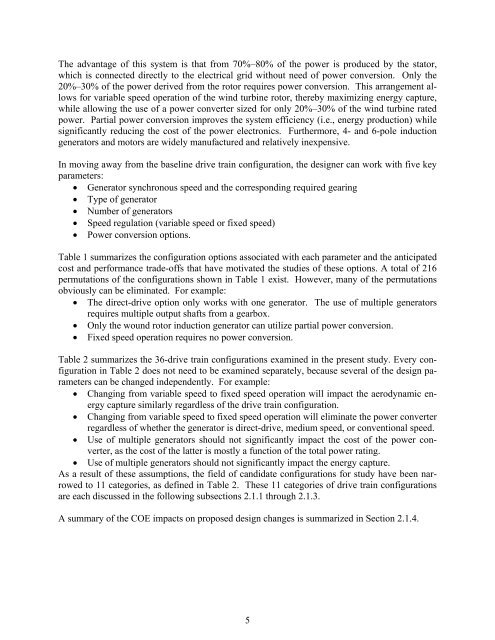Advanced Wind Turbine Program Next Generation Turbine ... - NREL
Advanced Wind Turbine Program Next Generation Turbine ... - NREL
Advanced Wind Turbine Program Next Generation Turbine ... - NREL
Create successful ePaper yourself
Turn your PDF publications into a flip-book with our unique Google optimized e-Paper software.
The advantage of this system is that from 70%–80% of the power is produced by the stator,<br />
which is connected directly to the electrical grid without need of power conversion. Only the<br />
20%–30% of the power derived from the rotor requires power conversion. This arrangement allows<br />
for variable speed operation of the wind turbine rotor, thereby maximizing energy capture,<br />
while allowing the use of a power converter sized for only 20%–30% of the wind turbine rated<br />
power. Partial power conversion improves the system efficiency (i.e., energy production) while<br />
significantly reducing the cost of the power electronics. Furthermore, 4- and 6-pole induction<br />
generators and motors are widely manufactured and relatively inexpensive.<br />
In moving away from the baseline drive train configuration, the designer can work with five key<br />
parameters:<br />
• Generator synchronous speed and the corresponding required gearing<br />
• Type of generator<br />
• Number of generators<br />
• Speed regulation (variable speed or fixed speed)<br />
• Power conversion options.<br />
Table 1 summarizes the configuration options associated with each parameter and the anticipated<br />
cost and performance trade-offs that have motivated the studies of these options. A total of 216<br />
permutations of the configurations shown in Table 1 exist. However, many of the permutations<br />
obviously can be eliminated. For example:<br />
• The direct-drive option only works with one generator. The use of multiple generators<br />
requires multiple output shafts from a gearbox.<br />
• Only the wound rotor induction generator can utilize partial power conversion.<br />
• Fixed speed operation requires no power conversion.<br />
Table 2 summarizes the 36-drive train configurations examined in the present study. Every configuration<br />
in Table 2 does not need to be examined separately, because several of the design parameters<br />
can be changed independently. For example:<br />
• Changing from variable speed to fixed speed operation will impact the aerodynamic energy<br />
capture similarly regardless of the drive train configuration.<br />
• Changing from variable speed to fixed speed operation will eliminate the power converter<br />
regardless of whether the generator is direct-drive, medium speed, or conventional speed.<br />
• Use of multiple generators should not significantly impact the cost of the power converter,<br />
as the cost of the latter is mostly a function of the total power rating.<br />
• Use of multiple generators should not significantly impact the energy capture.<br />
As a result of these assumptions, the field of candidate configurations for study have been narrowed<br />
to 11 categories, as defined in Table 2. These 11 categories of drive train configurations<br />
are each discussed in the following subsections 2.1.1 through 2.1.3.<br />
A summary of the COE impacts on proposed design changes is summarized in Section 2.1.4.<br />
5
















